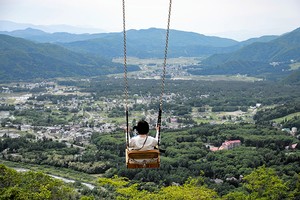By LISA VOGT/ Special to Asahi Weekly
December 5, 2023 at 07:30 JST
 Visitors climb stone steps that lead up toward the Yomeimon gate at Nikko Toshogu Shrine. The national treasure is covered with about 240,000 sheets of gold leaf and is decorated with 508 elaborate carvings of dragons, phoenixes and other imaginary animals as well as events and sages, including those from ancient China. (Photo by Lisa Vogt)
Visitors climb stone steps that lead up toward the Yomeimon gate at Nikko Toshogu Shrine. The national treasure is covered with about 240,000 sheets of gold leaf and is decorated with 508 elaborate carvings of dragons, phoenixes and other imaginary animals as well as events and sages, including those from ancient China. (Photo by Lisa Vogt)
My parents are in their 90s and thankfully, still kicking it. (My father says my mother is kicking him to clean the balcony, wash the dishes and fix the sliding closet doors.)
They bought a final resting plot about 20 years ago with a view of a Ferris wheel in the distance. They didn’t make the association, but I immediately smiled as it reminded me of the wheel of Dharma.
Why are humans, especially those who wielded power, so elaborately entombed? The Taj Mahal was built for an emperor’s favorite wife, the Les Invalides is Napoleon Bonaparte’s tomb, the pyramids are for Egyptian kings, and the Mausoleum of the First Qin Emperor has a circumference of more than 6 kilometers with thousands of terracotta statues.
A couple of hours north by train from Tokyo, nestled in a national park, stands Nikko Toshogu shrine, a grand tribute to Tokugawa Ieyasu (1542-1616), the founding figure behind the Tokugawa Shogunate, the dominant ruling power in Japan for more than two and a half centuries until the Meiji Restoration in 1868.
According to tradition, Ieyasu became the deity Tosho Daigongen upon death. Toshogu can be translated as “the radiant shrine of the east.” His son and successor, Hidetada, commissioned the shrine, and Ieyasu’s grandson, Iemitsu, transformed it into a grandiose complex of color and detail.
Nikko Toshogu is famous for many things: A stone torii gate was shipped from about 900 kilometers away by a daimyo of present-day Fukuoka; a five-storied pagoda stands with zodiac animals placed in 12 precise directions; the iconic image of the “See no evil, speak no evil, hear no evil” monkeys is carved on a storehouse wall, which is actually part of eight panels of monkey carvings that depict phases of a person’s life; the lavishly decorated Yomeimon gate has more gold leaves than Kyoto’s Kinkakuji temple and is in the Chinese karamon style, topped with a tsutsuga, a ferocious mythical animal, constructed using the golden ratio; and finally, the Honjido Hall features a giant dragon that looms above you and cries when two sticks of wood are clapped together under its head.
This shrine is quite a sight--and site, with 5,173 elaborate carvings in dazzling colors and vibrant designs in every direction. “Don’t say 'kekko,' or wonderful, until you’ve seen Nikko,” indeed.
As with other such destinations around the world, I’m not sure what to make of tourists outnumbering devotees. Is this Dharma? To know, I guess I’ll have to wait a long time for the bird to sing.
* * *
This article by Lisa Vogt, a Washington-born and Tokyo-based photographer, originally appeared in the Oct. 1 issue of Asahi Weekly. It is part of the series "Lisa’s UNESCO World Heritage Sites in Japan," which depicts various sites of outstanding universal value across the country through the perspective of the author, a professor at Aoyama Gakuin University.




















A peek through the music industry’s curtain at the producers who harnessed social media to help their idols go global.
A series based on diplomatic documents declassified by Japan’s Foreign Ministry
Here is a collection of first-hand accounts by “hibakusha” atomic bomb survivors.
Cooking experts, chefs and others involved in the field of food introduce their special recipes intertwined with their paths in life.
A series about Japanese-Americans and their memories of World War II